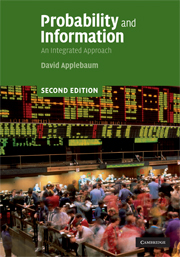
-
Select format
-
- Publisher:
- Cambridge University Press
- Publication date:
- 06 July 2010
- 14 August 2008
- ISBN:
- 9780511755262
- 9780521899048
- 9780521727884
- Dimensions:
- (246 x 189 mm)
- Weight & Pages:
- 0.73kg, 250 Pages
- Dimensions:
- (246 x 189 mm)
- Weight & Pages:
- 0.59kg, 290 Pages
You may already have access via personal or institutional login
Book description
This updated textbook is an excellent way to introduce probability and information theory to new students in mathematics, computer science, engineering, statistics, economics, or business studies. Only requiring knowledge of basic calculus, it starts by building a clear and systematic foundation to the subject: the concept of probability is given particular attention via a simplified discussion of measures on Boolean algebras. The theoretical ideas are then applied to practical areas such as statistical inference, random walks, statistical mechanics and communications modelling. Topics covered include discrete and continuous random variables, entropy and mutual information, maximum entropy methods, the central limit theorem and the coding and transmission of information, and added for this new edition is material on Markov chains and their entropy. Lots of examples and exercises are included to illustrate how to use the theory in a wide range of applications, with detailed solutions to most exercises available online for instructors.
Reviews
Reviews for the first edition:‘I found the book interesting and entertaining … The level of difficulty of the material is well judged …’
D. A. Stephens Source: The Statistician
‘This text provides a blend of the traditional disciplines of probability theory and the relatively new field of information science in a well written manner … the author succeeds in introducing concepts of probability theory gently paced and user friendly as stated on page xi of the preface … The blend of probability theory and information science makes this an innovative text... The innovative blend of probability theory and information theory make this text a good choice for teachers wanting to present both a traditional background and modern ideas to their students.’
Source: Journal of the American Statistical Association
‘Reviewing this book was a pleasure. Clearly the author is delighted by his subject and this attitude is communicated well … this is an excellent book which will make a stimulating text for Honours courses in probability for applied mathematicians, statisticians, physicists or engineers’
John M. Halley Source: The Statistician
'… a nice introductory text for a modern course on basic facts in the theory of probability and information. The author always has in mind that many students, especially those specializing in informatics and/or technical sciences, do not often have a firm background in traditional mathematics. Therefore he attempts to keep the development of material gently paced and user-friendly.'
Source: EMS Newsletter
Contents
Metrics
Full text views
Full text views help Loading metrics...
Loading metrics...
* Views captured on Cambridge Core between #date#. This data will be updated every 24 hours.
Usage data cannot currently be displayed.
Accessibility standard: Unknown
Why this information is here
This section outlines the accessibility features of this content - including support for screen readers, full keyboard navigation and high-contrast display options. This may not be relevant for you.
Accessibility Information
Accessibility compliance for the PDF of this book is currently unknown and may be updated in the future.


